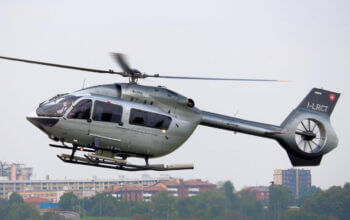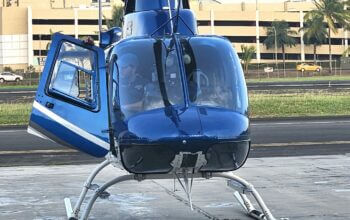Estimated reading time 22 minutes, 7 seconds.
For the second time in Canadian tactical aviation history, 1 Wing will deploy an aviation detachment comprised of at least 40 per cent reservists for an overseas operation.
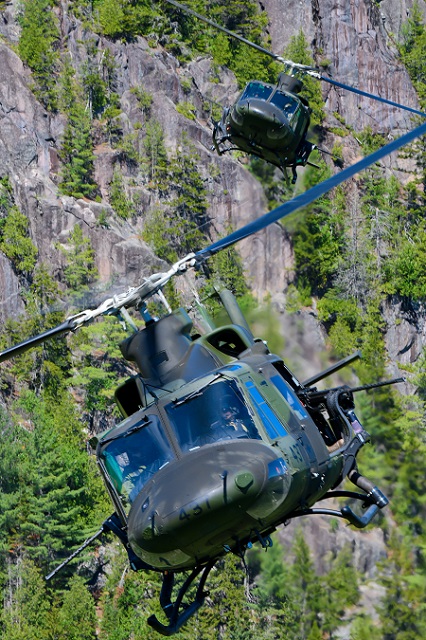
Pilots, aircrews, technicians and logisticians from 438 Tactical Helicopter Squadron in St. Hubert, Que., will deploy to Camp Taji airfield, approximately 30 kilometres north of Baghdad, to provide utility lift and transport for NATO Mission-Iraq, a new 12-month training and capacity building mission headed by Canadian MGen Dany Fortin.
Designated a total force air reserve squadron, 438 Squadron contains more than 50 per cent reservists to fulfil a mandate that includes responsibility for advanced aviation tactics instruction and the training school for CH-146 Griffon technicians, as well as support to the Land Aviation Tactics Evaluation Flight, the Royal Canadian Air Force’s (RCAF) sub-unit for land aviation test and evaluation for operational airworthiness. Its only previous overseas deployment in recent memory was to Afghanistan as the lead for a rotation providing the Sperwer unmanned aerial vehicle
“We integrate Reserve forces in all our units 365 days of the year, but 438 Squadron has a lot,” acknowledged Col Travis Morehen, commanding officer of 1 Wing Kingston, Ont. “Many of those reservists are former Regular force members, so there is a high standard of competence and excellence in that unit. We feel pretty confident they have the capability and capacity to deploy overseas for a year. And they are very happy to have the chance to participate.”
Their primary mission will be providing logistical support and transport within theatre for Fortin and his headquarters staff. However, while their three CH-146 Griffons will be equipped with standard protection such as the C6, GAU 21 or Dillon M134 machine guns, the helicopters won’t have a MX-15 camera or other sensors to conduct reconnaissance, close air support or convoy escort.
The aviation detachment of about 50 personnel, including clerks, supply technicians, aircraft technicians, aircrew and operational staff, is an example of how LGen Al Meinzinger, commander the Royal Canadian Air Force, intends to leverage the “bench strength” of the Reserves as the Air Force brings new aircraft into service, meets the demands of a high operational tempo, and manages a growing challenge retaining experienced personnel.
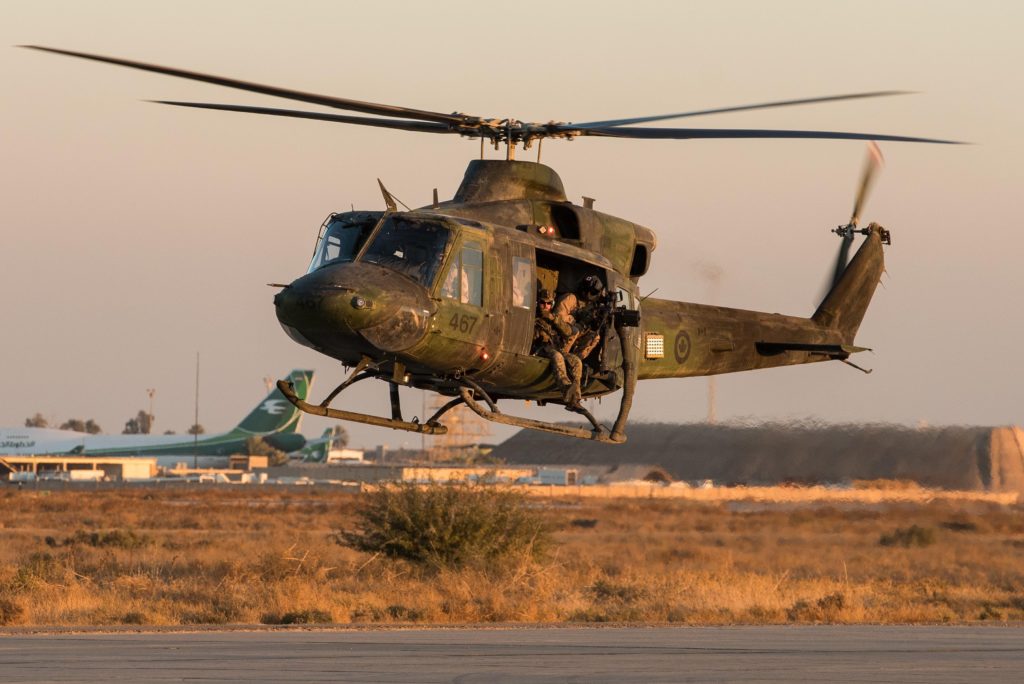
“We need to capitalize on their talent where we can to increase our operational capacity,” he told Skies in a recent interview about his goal to grow class A and B reservists by 400, either through recruitment or by encouraging those planning to retire from the Regular force to remain in service with the Reserves.
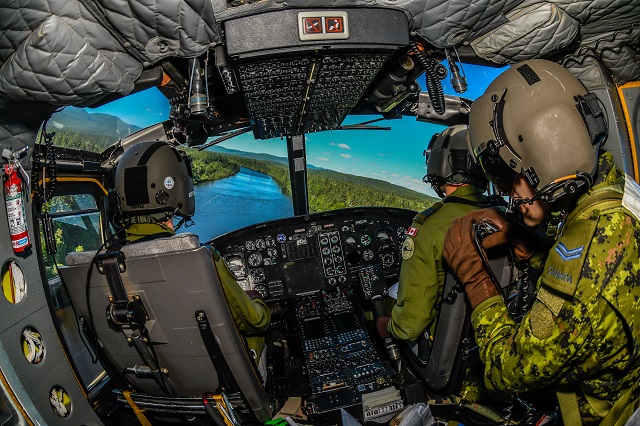
Morehen, who has about 430 reservists within the tactical aviation Wing of around 1,600, said the concentration of experienced reservists within 438 Squadron has offered him greater flexibility to manage the current rhythm of operations.
That 438 Squadron is in the mix for deployment is a sign of how stretched tactical aviation resources have become. The commitment to Taji might be small, but it comes on top of an ongoing mission of four Griffons based in the northern Iraqi city of Erbil, and a new United Nations aeromedical evacuation mission that began in July in Mali with five Griffons and three CH-147 Chinooks. (One of each Griffon and Chinook serve as an operational spare to ensure the forward aeromedical commitment is met.)
“The pace of operations and the concurrency of operations have created a situation where we have had to go to 438 Squadron,” said Morehen. “I wouldn’t want to put them in the rotation normally, but we are kind of in extraordinary circumstances right now.”
The aviation detachment in Erbil, which provides support to Canadian Special Operations Forces working with Iraqi security forces in the region, is now under the command of 427 Special Operations Aviation Squadron of Petawawa, Ont. The squadron opened the theatre in 2016 before handing off to rotations from 408 Tactical Helicopter Squadron of Edmonton, Alta., and 430 Tactical Helicopter Squadron of Valcartier, Que. Aircrews have been averaging around 3,000 flying hours per year, a demanding tempo for the Griffons and their technicians.

While 430 Squadron completes its high readiness training, the forward aeromedical evacuation detachment, based near the eastern Malian city of Goa, is comprised of a command team from 408 Squadron, along with its compliment of aircrews and technicians, as well as Chinook crews and techs from 450 Tactical Helicopter Squadron in Petawawa. The mission is slated to run until July 2019.
And then there is the domestic mission. In the past 12 months alone, 1 Wing aircrews have been tasked to respond to forest fires in British Columbia and Manitoba as well as floods in New Brunswick and northern Ontario.
“We can fulfil our current commitments, but if we were tasked with any more at this time, it would be a challenge,” admitted Morehen. “We’d find a way to get it done, but it wouldn’t meet our traditional deployment model.”
Sustaining multiple missions
Sustaining a tactical aviation detachment on one mission can present challenges; sustaining three theatres simultaneously is another matter. Goa, in particular, is a three-hour CC-130J Hercules ride from the Canadian Armed Forces logistics hub in Dakar, Senegal, which in turn is an eight-hour flight from 8 Wing Trenton, Ont., on a CC-177 Globemaster. And if it’s a single crew flying supplies from Canada, there’s a day of crew rest in Senegal before the flight can continue to Mali.
The Wing has acquired plenty of overseas experience with the Griffon since an aviation task force was deployed to Afghanistan in 2008–the aircraft flew over 16,000 flight hours and moved over 3,000 passengers and 20,000 pounds of cargo. The volume of supply flights and the lines of communication might be different than Kandahar, but the lessons on what is required to sustain a helicopter in desert conditions are well understood.
“We are used to operating the Griffon in a sparse or austere environment,” said Morehen, who served as the Wing lessons learned officer in 2002. “We know that with its increased age, every maintenance hour that we put on it is a little longer than the last one. We know the dust is abrasive, so we need more rotor blades, tail blades, windscreens, and we need to bring good vacuums. All those experiences before have allowed us to spare appropriately.
“But this is the first time we have deployed the Chinook in an austere environment with a long supply chain. We’re still doing modifications to it. We don’t have the institutional knowledge that we do with the Griffon. So we are finding the problems, but also the innovative solutions to support that mission.”
He recently watched a CH-147 being prepared for air transport and observed that where the Griffon could be loaded in a short time, the Chinook took several days. “Tearing that beast apart and getting it ready for transport, some guys are doing it for the first time,” he said. “Some of the guys were with the unit when it was stood up and they are still learning new procedures on how to do that complicated maintenance because they haven’t torn that bird apart and put it back together too many times before.”
Morehen, who will command the second rotation of the Joint Task Force in Mali beginning in January, said the third Chinook and fifth Griffon were deliberately added to the deployment to mitigate some of the risk of a long supply chain and ensure the forward aeromedical evacuation mission could be completed without maintenance delays.
“They are not flying aircraft, they are there purely to guarantee the mission,” he explained, noting that the task force area of responsibility is 24 times the size of Kandahar province and almost 1.5 times the size of Ontario. “The logistical challenges of supporting that are massive.”

Consequently, the usual risk assessment of each flight also includes managing fuel. The Griffon has a range of around 125 nautical miles, which includes time for the Chinook to land and extract injured UN troops. Expanding that requires establishing forward refueling points, which means putting a truck on the road, an exposure the task force tries to minimize.
However, that medical evacuation capability has quickly become integral to UN troops. Allies such as the Germans and Dutch often base their movements on the availability of airborne medical support. “If it’s bad weather or a broken aircraft, they stop moving because they are so reliant on that capability,” said Morehen.
Army angst
Tactical aviation is also integral to the Canadian Army’s concept of adaptive dispersed operations. Traditionally, the two have synchronized their high readiness training to validate the Army’s mechanized brigade groups and 1 Wing’s aviation battalions. At present, however, the Army is supporting missions in eastern Europe while the helicopters are in the Middle East and Africa.
“We have found ourselves challenged to match with the Army. Down to the rank and file in the units, we are feeling some angst about being separated because we don’t want to lose the successes we had in Afghanistan and we continue to work on,” acknowledged Morehen. “That is the role of tactical aviation, to support the light forces around the battlefield.”
While there is a concern that “perishable skills” such as call for fires or close combat attack could suffer, he said the Wing would engage as often as possible, though perhaps on a smaller scale, with the Army’s collective training exercises. And it would make a point of sending young officers, if not helicopters, to most other exercises to continue developing their detailed planning skills.
“We will still seek to use Exercise Maple Resolve and those collective training events as validation for our own training,” he said.
In a way, at least one element of the Army has become more integrated with tactical aviation than ever before. As part of the forward aeromedical evacuation capability, all Chinooks include a four-soldier protection team from the 3rd Battalion of the Royal 22nd Regiment to provide ground security and support the four-person medical team while airborne.
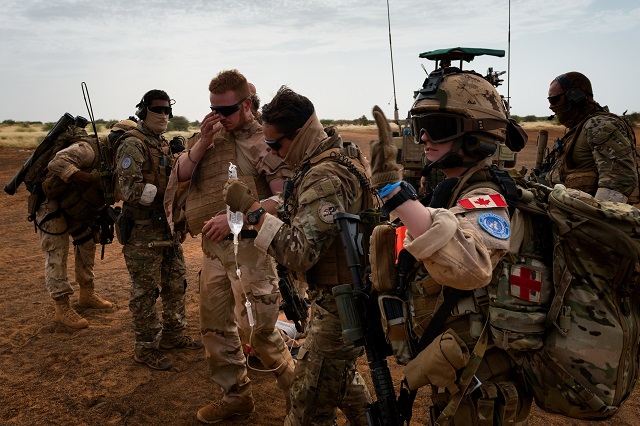
“That is a level of integration that we have never before achieved with 1 Wing,” said Morehen. “It’s incredible to see those young master corporals, corporals, even privates, seamlessly integrate with lieutenant-colonel trauma surgeons in the back of that Chinook.”
Upgrading on the fly
With the CH-147s reaching full operational capability (FOC) earlier this year, the deployment to Mali marks the first time the F-model Chinook has been overseas alongside the Griffons. Though the compliment of six operational aircraft does not fully constitute what the Wing calls an aviation battalion, it is emblematic of its relatively new flexible and scalable force employment concept that envisions the Griffons and Chinooks working in tandem.
Morehen, who assumed command of 1 Wing in July, said it is probably too early to assess how effective the concept has been at streamlining training, maintenance and the organizational responsibilities of each unit. The current operational tempo and ongoing challenges with retention among senior pilots and technicians make it difficult to define and measure metrics.
“We need to achieve the manning and trained effective strength we desire, and only then will we be able to validate the force employment concept in terms of its structural changes,” he said.
Though 450 Squadron has declared FOC, it has yet to reach its full strength of trained personnel. Technician training has taken longer than anticipated with the new aircraft, he noted. And that’s affecting the squadron’s ability to generate three aircrew and techs for successive rotations.
“That is a challenge and limiting factor,” he admitted. “Once we are able to fully achieve the manning and trained effective strength at 450 Squadron, that’s when we’ll be able to realize the potential and sustainability of the force employment concept.”
As with the rest of the Air Force, the loss of experienced personnel ultimately affects the training system where that expertise is passed on. Morehen said the Wing has “a backlog of aircrew waiting training” and is exploring all creative ideas to reduce training time. Some Griffon pilots and flight engineers with over 2,000 flight hours have transitioned to 450 Squadron. “They bring the tactical aviation culture, the leadership and planning skills to that unit” he observed, “but they still need to learn the machine.”
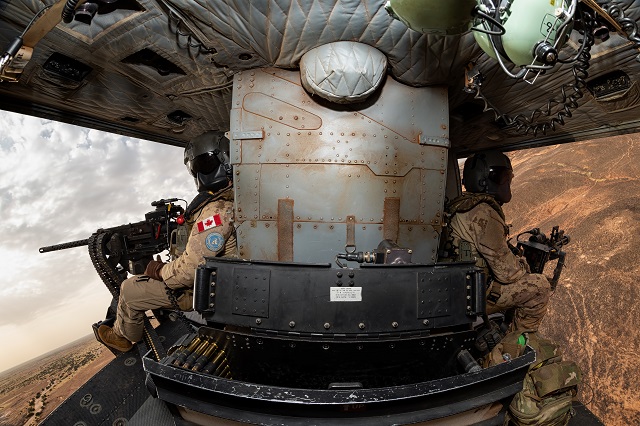
A new simulation training strategy, expected in late 2018 or early 2019, might offer further solutions. But the recent swell in operations may actually provide opportunities for the Wing that wouldn’t otherwise be possible.
The deployment is allowing co-pilots who would normally have to complete the basic tactical aviators course to upgrade to aircraft captains to acquire credit while on operations. “If they have been in Iraq or Mali for six months and they are meeting all of the training and performance objectives, then I am not averse to having recommendations from that chain of command to sign them off as having met the bill,” said Morehen. “That’s just one example where I’m happy to see some initiative and creativity.”
That same approach is being applied to technicians who are exceeding training requirements while maintaining operational helicopters under intense pressure. “It’s [a] fantastic thing to see people placed in those positions of adversity and rise to the challenge. By and large, they all excel. They do things they didn’t know they could do. They are expanding their knowledge, their viewpoint and their horizon. They find new ways to communicate, they develop those interpersonal skills because email doesn’t suffice in this high tempo environment. You actually need to talk to people and develop that common understanding.”

Morehen said he was surprised to learn that for over 60 per cent of personnel serving on current rotations, it was their first overseas deployment. Within seven years of his arrival at 427 Squadron in November 1995, he had deployed to Haiti with the CH-135 Twin Huey, Bosnia, and Honduras for Hurricane Mitch, and responded to floods in Winnipeg and an ice storm in eastern Ontario.
“It was kind of startling to see the absence of medals because people hadn’t deployed,” he said. “So a lot of people have that excitement because this is their first deployment.”
Griffon life extension
As effective as the Chinooks and Griffons have been together in Mali, they are at opposite ends of their respective service lives. The CH-147 has renewed a range of capability in the Wing, but the CH-146 is in need of an upgrade to its avionics and mission systems. A request for proposals is expected in 2019 for a limited life extension project that would upgrade cockpit avionics, instruments and displays with a digital configuration that would integrate mission equipment. The project is intended to bridge a gap until the Griffon is eventually replaced in the early 2030s.

At the same time, the Air Force will also likely complete an upgrade to the L-3 WESCAM MX-15 electro-optical and infrared (EO/IR) imaging sensor under the Interoperable Griffon Reconnaissance Escort Surveillance System (INGRESS) project to deal with obsolescence issues in the current camera.
The Wing will have its input into the project requirements. Morehen acknowledged pilots usually ask for the same things–more lift and speed and bigger guns, all of which would be welcomed. But he said the Griffon, while it has its limitations, has delivered everything that has been asked of it.
“I don’t think there are many nations that have been as agile and flexible with that type of platform as we have, whether it is the combat service support role for search and rescue; precision insertion for special operations on planes, trains or automobiles; utility lift; or providing stand-off fires with the GAU 21.”
And the prospect of expanded capability is prompting the Wing to consider what that might mean for tactical aviation and the force employment concept (FEC), or what Morehen has dubbed FEC 2.0. “It ought not to be too different from what it is now, [but] is there different training?”
While he hasn’t fully wrapped his mind around what should eventually replace the Griffon, he suggested the capability of the Chinook to move large numbers of infantry has changed the conversation. “Anything moving forward can’t just be a Griffon replacement. What are the next thrusts that tactical aviation needs to do? Is it more precision fires? Is it precision lift? Is it extended range? What are the components of airborne mobility, reconnaissance, fire powers–those traditional tactical aviation tasks? Where does the next aircraft fit in those?”
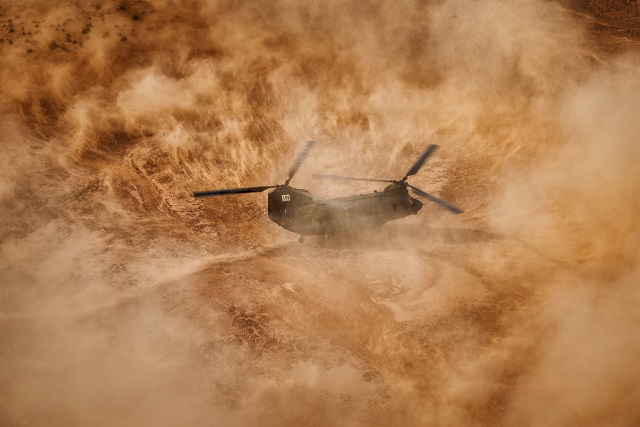
For now, though, Morehen is focused on sustaining multiple theatres while continuing to generate the aircrews and technicians that will be needed in the coming years. The Wing might be stretched almost to its limit, but he’s embracing the challenge, even if it is uncomfortable at times.
“I wouldn’t want much more at this time, but we shouldn’t be afraid to be at the edge of our capacity either,” he said. “Strength comes out of adversity and challenge. It’s forcing us to be creative and re-examine the way we currently do business. And it is certainly challenging our people to not be static in their thinking, to develop a bit of resilience to change.”





